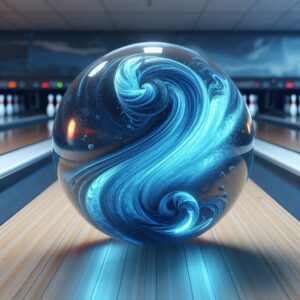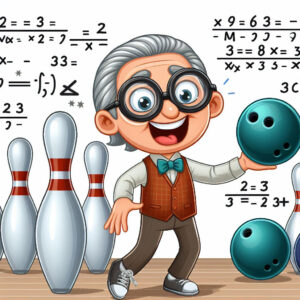As one of the most essential pieces of equipment in the sport of bowling, the bowling ball plays a critical role in determining a player’s performance on the lanes.
From the first wooden balls used centuries ago to the high-tech reactive resin balls of today, the composition and construction of bowling balls has evolved dramatically over time.
In this comprehensive guide, we’ll take a deep dive into the materials and manufacturing processes that go into creating modern bowling balls.
Whether you’re a seasoned bowler or just getting started, understanding the inner workings of these iconic sporting goods can help you make a more informed choice when selecting the right ball for your game.
Traditional Bowling Ball Materials
Tracing the history of bowling, the earliest iteration of the bowling ball was made from natural materials found in the environment. One of the most common early ball compositions was wood.
Wooden Bowling Balls
Bowling can be traced back hundreds of years, with some of the earliest evidence pointing to forms of the game being played in ancient Egypt, Greece, and Rome. During these formative eras, the bowling ball was typically fashioned from carved hardwoods like oak, maple, or beechwood.
The properties of wood lent themselves well to the needs of early bowling. It was a readily available material that could be shaped and formed into a smooth, spherical shape suitable for rolling down primitive bowling lanes. Wooden balls also had a pleasing aesthetic that matched the rustic environments where the sport was played.
However, wooden balls did have some significant drawbacks. They tended to be on the heavier side, weighing anywhere from 6 to 16 pounds. This placed physical demands on players, especially when executing powerful rolls. Wooden balls also lacked the responsiveness and hook potential of modern ball materials, making it more challenging to control the ball’s path and knock down pins with precision.
As bowling evolved and gained popularity, the search was on for alternative ball materials that could address these limitations.
Rubber Bowling Balls
The next major development in bowling ball composition came with the rise of rubber in the early 20th century. Rubber offered several advantages over wood that helped advance the sport:
- Lighter weight – Rubber balls could be produced at weights ranging from 6 to 10 pounds, reducing physical strain on players.
- Increased responsiveness – The pliable nature of rubber allowed for more hook and curve on ball rolls.
- Improved durability – Rubber balls were less prone to chipping, cracking, or other damage compared to wood.
The transition to rubber bowling balls opened up new frontiers in performance and technology. Manufacturers began experimenting with different rubber formulations and molding techniques to craft balls with increasingly specialized properties.
Some early rubber ball models featured a solid, homogeneous composition. Others incorporated a hollow core or internal weight block to further manipulate the ball’s weight, balance, and overall dynamics. These innovations laid the groundwork for the even more advanced bowling ball designs we see today.
Despite their advantages, rubber balls also had their limitations. The hook potential and overall ball motion were still somewhat restricted compared to modern materials. Bowlers eventually sought out even more advanced technologies to enhance their game.
The Modern Bowling Ball
As the 20th century progressed, bowling equipment continued to evolve at a rapid pace. The search for new ball materials led to the development of synthetic compounds that offered unparalleled performance benefits.
Polyester (Plastic) Bowling Balls
One of the most significant breakthroughs came with the introduction of polyester (or plastic) as a bowling ball material. Polyester balls started gaining popularity in the 1960s and 1970s, offering bowlers a host of advantages:
Composition and Manufacturing
Polyester bowling balls are produced through an injection molding process. Pellets of polyester resin are heated and forced into a mold cavity, where the material cools and solidifies into the desired ball shape. This manufacturing method allows for a high degree of precision and consistency in the final product.
The polyester compound itself is a synthetic polymer material known for its strength, durability, and smooth, slick surface. These inherent properties translate well to the needs of a high-performance bowling ball.
Performance Characteristics
Compared to their rubber predecessors, polyester balls demonstrated several key performance benefits:
- Reduced hook potential – The slick polyester surface resulted in a straighter, more controlled ball path down the lane. This was ideal for players with a less aggressive bowling style.
- Increased pin carry – The solid construction and weight distribution of polyester balls helped generate more powerful, pin-crushing impact on the pocket.
- Improved consistency – Polyester’s uniformity and lack of surface texture provided a more predictable and reliable ball motion.
The combination of these factors made polyester balls a popular choice among recreational and league bowlers who prioritized accuracy, power, and repeatability in their game.
Urethane Bowling Balls
While polyester balls offered a noticeable step forward in bowling ball technology, some players craved even more advanced performance characteristics. This led to the emergence of urethane as a premium ball material in the 1980s.
Composition and Manufacturing
Urethane bowling balls are produced through a similar injection molding process as polyester, but with a key difference in the raw material. Instead of polyester resin, urethane balls are made from a specialized urethane compound.
Urethane is a synthetic polymer that shares some similarities with polyester, but with a more elastic and pliable molecular structure. This gives urethane balls a distinct “feel” and performance profile compared to their polyester counterparts.
Performance Characteristics
The unique properties of urethane provide bowlers with several distinct advantages:
- Increased hook potential – The textured urethane surface interacts more aggressively with the lane, allowing for greater ball hook and backend movement.
- Enhanced ball reaction – Urethane balls demonstrate a more dynamic, responsive motion as they transition from the breakpoint to the pocket.
- Improved ball control – The softer, more forgiving nature of urethane gives bowlers enhanced control and fine-tuned adjustability.
These attributes make urethane balls particularly appealing for players with a more aggressive, high-rev bowling style. The enhanced hook and backend motion can be a powerful weapon for experienced bowlers looking to attack the pins with precision.
Reactive Resin Bowling Balls
While urethane represented a significant leap forward in bowling ball technology, the relentless pursuit of performance innovations has continued to this day. The latest frontier in ball composition comes in the form of reactive resin.
Composition and Manufacturing
Reactive resin bowling balls are constructed using an advanced polymer compound that combines the strengths of both polyester and urethane. The specific formulation and manufacturing process can vary between brands and models, but the end result is a ball with exceptional responsiveness and versatility.
At the core of a reactive resin ball is a dense, heavy core material, often made from materials like steel or ceramic. This weight block is then encased in multiple layers of the reactive resin cover stock. The combination of the dense core and high-performance cover creates a ball with unparalleled power and hook potential.
Performance Characteristics
Reactive resin balls offer bowlers an elite level of performance that addresses the limitations of previous materials:
- Extreme hook potential – The reactive resin surface interacts aggressively with the lane, generating sharp, violent hook motion on the backend.
- Customizable ball motion – Bowlers can fine-tune the ball’s reaction by selecting from a wide range of reactive resin formulations, each with their own unique characteristics.
- Versatility across conditions – Reactive resin balls demonstrate impressive versatility, allowing players to handle a broad range of lane conditions.
These advanced capabilities make reactive resin balls a favorite choice among professional and elite amateur bowlers. However, their high-performance nature also means a steeper learning curve for less experienced players.
Ball Core and Weight Block
Alongside the various cover stock materials, the internal construction of a bowling ball also plays a pivotal role in its performance.
Core Types
At the center of every bowling ball lies the core – a dense, weighted component that helps determine the ball’s overall weight, balance, and dynamics. There are several different core configurations used in modern ball designs:
- Solid cores – A uniform, solid piece of material, often plastic or rubber, that makes up the entire inner portion of the ball.
- Pancake cores – A flat, disc-shaped weight block encased within the ball’s outer layers.
- Disk cores – A cylindrical weight block positioned within the ball.
The specific core type, size, and placement can have a significant impact on how the ball reacts on the lane. Manufacturers strategically engineer these internal components to achieve desired performance characteristics.
Weight Block Composition
In addition to the core configuration, the actual material used for the weight block is also a critical factor. Dense, heavy materials like steel or ceramic are commonly utilized to provide the necessary weight and dynamic forces.
The weight block is a key determinant of the ball’s overall weight, which can range anywhere from 6 to 16 pounds for adult leagues. Heavier weight blocks allow for more powerful ball motion and pin carry, while lighter weight blocks reduce physical strain on the bowler.
Choosing the Right Bowling Ball Material
With such a wide array of bowling ball compositions and constructions available, selecting the optimal ball for your game can be a daunting task. However, by understanding the unique properties and performance attributes of each material, you can make a more informed decision.
When choosing a bowling ball, start by carefully evaluating your current skill level, bowling style, and the specific demands of the lane conditions you typically face. This will help you identify the key ball characteristics that will be most beneficial for your game.
For example, if you’re an experienced bowler with a high-rev, aggressive style, a reactive resin ball may be the ideal choice. The extreme hook potential and dynamic responsiveness can be a powerful weapon on the lanes.
Conversely, if you’re new to the sport or have a smoother, more controlled approach, a polyester or urethane ball may be a better fit, offering greater consistency and predictability.
It’s also worth considering the type of lane conditions you encounter most often. Harder, drier lane surfaces typically call for a ball with more hook potential, like urethane or reactive resin. Softer, more oily lanes may require a ball with less aggressive hook, such as polyester, to avoid over-reacting and losing control.
Ultimately, the “best” bowling ball material is the one that aligns most closely with your personal bowling style, skill level, and the specific demands of your local lanes. Invest the time to research, test, and experiment with different ball compositions to find the perfect match for your game.
Conclusion
From the earliest wooden balls to the high-tech reactive resin wonders of today, the evolution of bowling ball materials has been a driving force behind the continued advancement of the sport.
Each new breakthrough in composition and construction has unlocked new levels of performance, control, and versatility for bowlers of all skill levels.
Understanding the unique properties and capabilities of different ball materials is crucial for making an informed equipment choice. Whether you’re a seasoned veteran or just starting out, taking the time to explore the latest bowling ball technologies can help you unlock your full potential on the lanes.
So the next time you’re shopping for a new ball, don’t just focus on the aesthetics or brand name. Dive deeper into the composition and inner workings to find the perfect match for your game. With the right ball in hand, you’ll be on your way to striking success in no time.





